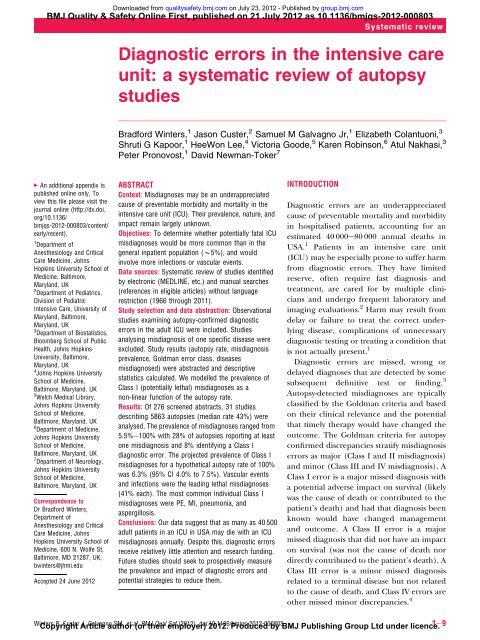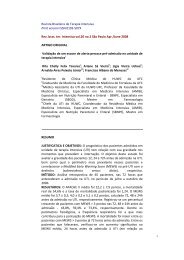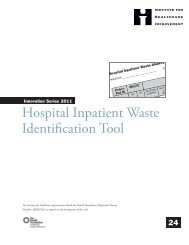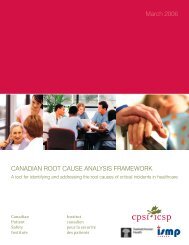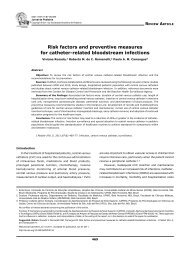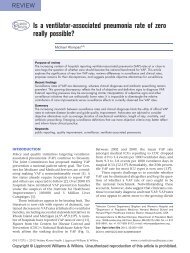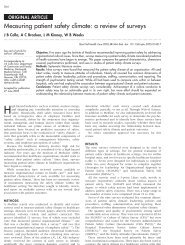Diagnostic errors in the intensive care unit: a systematic review of ...
Diagnostic errors in the intensive care unit: a systematic review of ...
Diagnostic errors in the intensive care unit: a systematic review of ...
Create successful ePaper yourself
Turn your PDF publications into a flip-book with our unique Google optimized e-Paper software.
Downloaded from qualitysafety.bmj.com on July 23, 2012 - Published by group.bmj.comBMJ Quality & Safety Onl<strong>in</strong>e First, published on 21 July 2012 as 10.1136/bmjqs-2012-000803Systematic <strong>review</strong><strong>Diagnostic</strong> <strong>errors</strong> <strong>in</strong> <strong>the</strong> <strong>in</strong>tensive <strong>care</strong><strong>unit</strong>: a <strong>systematic</strong> <strong>review</strong> <strong>of</strong> autopsystudiesBradford W<strong>in</strong>ters, 1 Jason Custer, 2 Samuel M Galvagno Jr, 1 Elizabeth Colantuoni, 3Shruti G Kapoor, 1 HeeWon Lee, 4 Victoria Goode, 5 Karen Rob<strong>in</strong>son, 6 Atul Nakhasi, 3Peter Pronovost, 1 David Newman-Toker 7< An additional appendix ispublished onl<strong>in</strong>e only. Toview this file please visit <strong>the</strong>journal onl<strong>in</strong>e (http://dx.doi.org/10.1136/bmjqs-2012-000803/content/early/recent).1 Department <strong>of</strong>Anes<strong>the</strong>siology and CriticalCare Medic<strong>in</strong>e, JohnsHopk<strong>in</strong>s University School <strong>of</strong>Medic<strong>in</strong>e, Baltimore,Maryland, UK2 Department <strong>of</strong> Pediatrics,Division <strong>of</strong> PediatricIntensive Care, University <strong>of</strong>Maryland, Baltimore,Maryland, UK3 Department <strong>of</strong> Biostatistics,Bloomberg School <strong>of</strong> PublicHealth, Johns Hopk<strong>in</strong>sUniversity, Baltimore,Maryland, UK4 Johns Hopk<strong>in</strong>s UniversitySchool <strong>of</strong> Medic<strong>in</strong>e,Baltimore, Maryland, UK5 Welch Medical Library,Johns Hopk<strong>in</strong>s UniversitySchool <strong>of</strong> Medic<strong>in</strong>e,Baltimore, Maryland, UK6 Department <strong>of</strong> Medic<strong>in</strong>e,Johns Hopk<strong>in</strong>s UniversitySchool <strong>of</strong> Medic<strong>in</strong>e,Baltimore, Maryland, UK7 Department <strong>of</strong> Neurology,Johns Hopk<strong>in</strong>s UniversitySchool <strong>of</strong> Medic<strong>in</strong>e,Baltimore, Maryland, UKCorrespondence toDr Bradford W<strong>in</strong>ters,Department <strong>of</strong>Anes<strong>the</strong>siology and CriticalCare Medic<strong>in</strong>e, JohnsHopk<strong>in</strong>s University School <strong>of</strong>Medic<strong>in</strong>e, 600 N. Wolfe St,Baltimore, MD 21287, UK;bw<strong>in</strong>ters@jhmi.eduAccepted 24 June 2012ABSTRACTContext: Misdiagnoses may be an underappreciatedcause <strong>of</strong> preventable morbidity and mortality <strong>in</strong> <strong>the</strong><strong>in</strong>tensive <strong>care</strong> <strong>unit</strong> (ICU). Their prevalence, nature, andimpact rema<strong>in</strong> largely unknown.Objectives: To determ<strong>in</strong>e whe<strong>the</strong>r potentially fatal ICUmisdiagnoses would be more common than <strong>in</strong> <strong>the</strong>general <strong>in</strong>patient population (w5%), and would<strong>in</strong>volve more <strong>in</strong>fections or vascular events.Data sources: Systematic <strong>review</strong> <strong>of</strong> studies identifiedby electronic (MEDLINE, etc.) and manual searches(references <strong>in</strong> eligible articles) without languagerestriction (1966 through 2011).Study selection and data abstraction: Observationalstudies exam<strong>in</strong><strong>in</strong>g autopsy-confirmed diagnostic<strong>errors</strong> <strong>in</strong> <strong>the</strong> adult ICU were <strong>in</strong>cluded. Studiesanalys<strong>in</strong>g misdiagnosis <strong>of</strong> one specific disease wereexcluded. Study results (autopsy rate, misdiagnosisprevalence, Goldman error class, diseasesmisdiagnosed) were abstracted and descriptivestatistics calculated. We modelled <strong>the</strong> prevalence <strong>of</strong>Class I (potentially lethal) misdiagnoses as anon-l<strong>in</strong>ear function <strong>of</strong> <strong>the</strong> autopsy rate.Results: Of 276 screened abstracts, 31 studiesdescrib<strong>in</strong>g 5863 autopsies (median rate 43%) wereanalysed. The prevalence <strong>of</strong> misdiagnoses ranged from5.5%e100% with 28% <strong>of</strong> autopsies report<strong>in</strong>g at leastone misdiagnosis and 8% identify<strong>in</strong>g a Class Idiagnostic error. The projected prevalence <strong>of</strong> Class Imisdiagnoses for a hypo<strong>the</strong>tical autopsy rate <strong>of</strong> 100%was 6.3% (95% CI 4.0% to 7.5%). Vascular eventsand <strong>in</strong>fections were <strong>the</strong> lead<strong>in</strong>g lethal misdiagnoses(41% each). The most common <strong>in</strong>dividual Class Imisdiagnoses were PE, MI, pneumonia, andaspergillosis.Conclusions: Our data suggest that as many as 40 500adult patients <strong>in</strong> an ICU <strong>in</strong> USA may die with an ICUmisdiagnoses annually. Despite this, diagnostic <strong>errors</strong>receive relatively little attention and research fund<strong>in</strong>g.Future studies should seek to prospectively measure<strong>the</strong> prevalence and impact <strong>of</strong> diagnostic <strong>errors</strong> andpotential strategies to reduce <strong>the</strong>m.INTRODUCTION<strong>Diagnostic</strong> <strong>errors</strong> are an underappreciatedcause <strong>of</strong> preventable mortality and morbidity<strong>in</strong> hospitalised patients, account<strong>in</strong>g for anestimated 40 000e80 000 annual deaths <strong>in</strong>USA. 1 Patients <strong>in</strong> an <strong>in</strong>tensive <strong>care</strong> <strong>unit</strong>(ICU) may be especially prone to suffer harmfrom diagnostic <strong>errors</strong>. They have limitedreserve, <strong>of</strong>ten require fast diagnosis andtreatment, are <strong>care</strong>d for by multiple cl<strong>in</strong>iciansand undergo frequent laboratory andimag<strong>in</strong>g evaluations. 2 Harm may result fromdelay or failure to treat <strong>the</strong> correct underly<strong>in</strong>gdisease, complications <strong>of</strong> unnecessarydiagnostic test<strong>in</strong>g or treat<strong>in</strong>g a condition thatis not actually present. 1<strong>Diagnostic</strong> <strong>errors</strong> are missed, wrong ordelayed diagnoses that are detected by somesubsequent def<strong>in</strong>itive test or f<strong>in</strong>d<strong>in</strong>g. 3Autopsy-detected misdiagnoses are typicallyclassified by <strong>the</strong> Goldman criteria and basedon <strong>the</strong>ir cl<strong>in</strong>ical relevance and <strong>the</strong> potentialthat timely <strong>the</strong>rapy would have changed <strong>the</strong>outcome. The Goldman criteria for autopsyconfirmed discrepancies stratify misdiagnosis<strong>errors</strong> as major (Class I and II misdiagnosis)and m<strong>in</strong>or (Class III and IV misdiagnosis). AClass I error is a major missed diagnosis witha potential adverse impact on survival (likelywas <strong>the</strong> cause <strong>of</strong> death or contributed to <strong>the</strong>patient’s death) and had that diagnosis beenknown would have changed managementand outcome. A Class II error is a majormissed diagnosis that did not have an impacton survival (was not <strong>the</strong> cause <strong>of</strong> death nordirectly contributed to <strong>the</strong> patient’s death). AClass III error is a m<strong>in</strong>or missed diagnosisrelated to a term<strong>in</strong>al disease but not relatedto <strong>the</strong> cause <strong>of</strong> death, and Class IV <strong>errors</strong> areo<strong>the</strong>r missed m<strong>in</strong>or discrepancies. 4W<strong>in</strong>tersCopyrightB, CusterArticle J, GalvagnoauthorSM, et al.(orBMJ<strong>the</strong>irQualemployer)Saf (2012). doi:10.1136/bmjqs-2012-0008032012. Produced by BMJ Publish<strong>in</strong>g Group Ltd under licence. 1e9
Downloaded from qualitysafety.bmj.com on July 23, 2012 - Published by group.bmj.comSystematic <strong>review</strong>would not have changed <strong>the</strong>rapy. Class III and Class IVare m<strong>in</strong>or <strong>errors</strong> related to <strong>the</strong> term<strong>in</strong>al disease but notdeath and completely unrelated to ei<strong>the</strong>r, respectively.7e16 18e32 34e37The majority <strong>of</strong> studies reported Class Iand II 7 9 10 12 13 15 16 18e32 34e36 error data, and9 10 12 13 15 16 18e20 22 26 30 31less reported Class IIIand IV 9121316182023 error data.We def<strong>in</strong>ed four broad disease categories to assess <strong>the</strong>distribution <strong>of</strong> types <strong>of</strong> misdiagnoses. These categories<strong>in</strong>cluded: (1) vascular (myocardial <strong>in</strong>farction, pulmonaryembolus, stroke, any organ <strong>in</strong>farct, any vesselrupture or dissection, and any haemorrhage), (2)<strong>in</strong>fectious (bacterial, aspergillosis, o<strong>the</strong>r fungal, viral,and tuberculosis), (3) mechanical pathophysiologicalstates (cardiac tamponade, bowel obstruction, perforatedviscus, congestive heart failure, and cardiac valvefailure), and (4) neoplastic/o<strong>the</strong>r. Some studies treatedpneumonia and aspergillosis separately from o<strong>the</strong>r<strong>in</strong>fections. 10 14 19 20 25 34 We aggregated <strong>the</strong>se resultsdur<strong>in</strong>g <strong>the</strong> analytic phase.Data were tabulated us<strong>in</strong>g Micros<strong>of</strong>t Excel 2008 forMac (Micros<strong>of</strong>t Corp., Redmond, Wash<strong>in</strong>gton, USA).Descriptive statistics were calculated us<strong>in</strong>g Stata V.11(Stata Corp., College Station). A p value
Systematic <strong>review</strong>Downloaded from qualitysafety.bmj.com on July 23, 2012 - Published by group.bmj.comTable 1Included studies <strong>of</strong> <strong>in</strong>tensive <strong>care</strong> <strong>unit</strong> (ICU) misdiagnoses <strong>in</strong> generalAuthor Year Country Type <strong>of</strong> studyLength <strong>of</strong>study period(months)ICU typeTotal # <strong>of</strong>deathsNo <strong>of</strong>autopsiesused foranalysisBerlot 7 1999 Italy Retrospective 36 Mixed 346 159Blosser 8 1998 USA Retrospective 12 Med/132 41coronaryCombes 9 2004 France Prospective 36 Med/surg 315 167Dimopolous 10 2004 Belgium Retrospective 12 Med/surg 489 222Duke 11 1999 Australia Retrospective 24 Not given 238 Not givenFernandez-Segoviano 12 1988 Spa<strong>in</strong> Prospective 30 Mixed Not given 100Fish 13 2000 USA Retrospective 72 Burn 94 88Gera<strong>in</strong> 14 1990 Belgium Retrospective 11 Oncology 48 34Gut 15 1999 Brazil Retrospective 36 Med/surg 152 30Kall<strong>in</strong>en 16 2008 F<strong>in</strong>land Retrospective 72 Burn 74 71Koch 17 2008 Germany Retrospective 120 Medical 1205 1205Magret 18 2006 Spa<strong>in</strong> Retrospective 46 Mixed 525 80Maris 19 2007 Belgium Retrospective 24 Med/surg 786 289Mort 20 1999 USA Retrospective 72 Surg 560 149Nadrous 21 2003 USA Retrospective 24 Multiple 1597 455Ong 22 2002 USA Retrospective 24 Trauma/burn 158 153Palazon-Sanchez 23 1999 Spa<strong>in</strong> Retrospective 12 Med/surg 67 24Papadakis 24 1991 USA Retrospective 24 Medical 401 172Pastores 25 2007 USA Retrospective 69 Med/surg 658 86Perk<strong>in</strong>s 26 2003 Great Brita<strong>in</strong> Retrospective 42 Med/surg 636 38Podbregar 27 2001 Slovenia Retrospective 24 Medical 270 126Podbregar 28 2011 Slovenia Retrospective 20 Medical 373 170Roosen 29 2000 Belgium Retrospective 24 Medical 108 100Saad 30 2007 Brazil Retrospective 24 Coronary Unclear 161Sharma 31 2005 India Retrospective 36 Trauma/burn 249 163Silfvast 32 2003 F<strong>in</strong>land Retrospective 48 Mixed 388 346Simon 33 2001 Hungary Retrospective 12 Medical 163 110Tai 34 2001 USA Retrospective 24 Medical 401 91Tejer<strong>in</strong>a 2010 Spa<strong>in</strong> Retrospective 300 Mixed 2857 866Twigg 36 2001 Great Brita<strong>in</strong> Retrospective 36 Med/surg 252 97Yalamarthi 37 1998 Great Brita<strong>in</strong> Retrospective 24 Not given 233 70ICU, Intensive Care Unit.potentially lethal), and 15% were Class II (major but notlethal) despite presumably aggressive diagnostic assessment<strong>in</strong> <strong>the</strong> critical <strong>care</strong> environment. Given <strong>the</strong> 540 000deaths annually dur<strong>in</strong>g or immediately follow<strong>in</strong>g an ICUstay, 48 and extrapolat<strong>in</strong>g to a 100% autopsy rate, ourf<strong>in</strong>d<strong>in</strong>gs suggest that 34 000 (95% CI ¼22 600 to 40 500)ICU patients <strong>in</strong> <strong>the</strong> US may die as a result <strong>of</strong> a Class Ierror annually, assum<strong>in</strong>g that <strong>the</strong> error was <strong>the</strong> cause <strong>of</strong>death. This predicted number is comparable to <strong>the</strong> estimateddeaths from central l<strong>in</strong>e-associated bloodstream<strong>in</strong>fections <strong>in</strong> <strong>the</strong> ICU 49 and from breast cancer 50 <strong>in</strong> <strong>the</strong>US, and does not consider misdiagnosis-related morbidityamong <strong>in</strong>tensive <strong>care</strong> patients. These results also suggestthat despite <strong>the</strong> dropp<strong>in</strong>g autopsy rate over time, autopsyrema<strong>in</strong>s a crucial asset especially <strong>in</strong> ICU patients.We proved our hypo<strong>the</strong>sis that <strong>in</strong>fections and vascularevents would culm<strong>in</strong>ate a large majority <strong>of</strong> <strong>the</strong> diagnostic<strong>errors</strong>. Vascular events and <strong>in</strong>fections were <strong>the</strong> lead<strong>in</strong>gpotentially lethal misdiagnoses account<strong>in</strong>g for almost82% <strong>of</strong> potentially lethal Class I <strong>errors</strong> and almost 76%<strong>of</strong> <strong>the</strong> serious but not lethal Class II <strong>errors</strong>. Neoplasticdisease was <strong>the</strong> third most common overall misdiagnosiscategory but was rarely deemed lethal. Mechanicalpathophysiological states were uncommon. Importantly,pulmonary embolus, myocardial <strong>in</strong>farction, pneumonia,and aspergillosis accounted for over one-third <strong>of</strong> all ClassI misdiagnoses. These four particular diagnostic <strong>errors</strong>may be useful as outcome measure for design<strong>in</strong>g early<strong>in</strong>terventions to reduce diagnostic <strong>errors</strong> as a whole.Our results add new <strong>in</strong>formation to <strong>the</strong> field <strong>of</strong> diagnosticerror research. Shojania et al 5 conducteda <strong>systematic</strong> <strong>review</strong> <strong>of</strong> autopsy-detected diagnostic errorprevalence rates over time, but <strong>the</strong>y did not describespecific misdiagnoses <strong>in</strong> <strong>the</strong> ICU or elsewhere. We<strong>in</strong>cluded <strong>the</strong> seven ICU studies from <strong>the</strong>ir <strong>review</strong> <strong>in</strong> ouranalysis to <strong>of</strong>fer ref<strong>in</strong>ed estimates <strong>of</strong> <strong>the</strong> prevalence <strong>of</strong>4e9W<strong>in</strong>ters B, Custer J, Galvagno SM, et al. BMJ Qual Saf (2012). doi:10.1136/bmjqs-2012-000803
Downloaded from qualitysafety.bmj.com on July 23, 2012 - Published by group.bmj.comSystematic <strong>review</strong>Table 2 Condition/disease specific misdiagnosis studies not analysedDisease ordiagnosisNo <strong>of</strong>misseddiagnosesNo <strong>of</strong>autopsiesanalysedTotal no<strong>of</strong> deathsStudyperiod(mos) ICU typeAuthor Year Country Type <strong>of</strong> studydeHempt<strong>in</strong>ne 38 2009 Belgium Retrospective 36 Med/surg 169 64 15 ARDS onlyDu 39 1996 Ch<strong>in</strong>a Retrospective 492 Surg Not given 3447 80 Fungal onlyHasani 40 2005 Iran Prospective 12 Mixed Not given 43 2 Men<strong>in</strong>gitis onlyJanson 41 1976 Germany Retrospective 24 Surg 100 100 48 CXR misDx onlyPetersen 43 1999 Denmark Prospective 12 Multiple 659 141 70 Pneumonia onlyP<strong>in</strong>heiro 44 2007 Brazil Retrospective 96 Not given 592 22 7 ARDS onlyAl-Saidi 42 2002 Canada Retrospective 67 Med/surg 59 28 10 Bone marrowtransplant onlyTejer<strong>in</strong>a 45 2009 Spa<strong>in</strong> Retrospective 150 Not given 1633 253 111 VAP onlyRetrospective 120 Coronary Not given 31 12 PE onlyWidimsky 46 1985 Czech-SlovakiaARDS, Acute Respiratory Distress syndrome; CXR, chest X-ray; ICU, Intensive Care Unit; misDx, misdiagnosis; mos, months; PE, pulmonary embolus; VAP, ventilator-associated pneumonia.misdiagnoses <strong>in</strong> <strong>the</strong> ICU by error class and autopsy rate.Shojania et al projected that, despite a reduction <strong>of</strong> 33%<strong>in</strong> <strong>the</strong> rate <strong>of</strong> class I <strong>errors</strong> over 4 decades, a US hospitalwould likely cont<strong>in</strong>ue to observe a class I error at a rate<strong>of</strong> 4.1%e6.7% across all patients. While a few <strong>of</strong> <strong>the</strong>studies <strong>in</strong> Shojania’s <strong>review</strong> <strong>in</strong>cluded ICU patients <strong>in</strong>addition to general ward and emergency departmentpatients, our results suggest that <strong>the</strong> rate <strong>of</strong> class I <strong>errors</strong>are 16%e48% higher <strong>in</strong> <strong>the</strong> ICU patient population<strong>the</strong>n <strong>the</strong> general hospital patient population as a whole.Methodologically, we found that autopsy rates <strong>of</strong> 30%e40% or higher are likely to produce fairly accurate estimates<strong>of</strong> <strong>the</strong> overall prevalence <strong>of</strong> potentially lethalmisdiagnoses <strong>in</strong> <strong>the</strong> ICU population, despite potentialbiases <strong>in</strong>herent <strong>in</strong> autopsy case selection. 51Observed diagnostic error frequencies were highest <strong>in</strong>studies with <strong>the</strong> lowest autopsy rates. Cl<strong>in</strong>ical selection <strong>of</strong><strong>the</strong> most complex cases to undergo autopsy is believed tocontribute to this effect. 51 To counter this effect, we havemodelled <strong>the</strong> measured error frequency as a function <strong>of</strong>autopsy rate, controlled for study size and time andextrapolated out to conditions <strong>of</strong> 100% autopsy. Never<strong>the</strong>less,it is possible that o<strong>the</strong>r factors may contribute to<strong>the</strong> difference seen <strong>in</strong> studies with low autopsy rates suchas a more detailed and rigorous approach to autopsy anderror f<strong>in</strong>d<strong>in</strong>g. Additionally, <strong>the</strong> level <strong>of</strong> diagnosticcerta<strong>in</strong>ty as to <strong>the</strong> cause <strong>of</strong> death is likely to <strong>in</strong>fluence <strong>the</strong>autopsy rate. Podbregar et al 27 attempted to measure this<strong>in</strong>fluence f<strong>in</strong>d<strong>in</strong>g that diagnostic certa<strong>in</strong>ty significantly<strong>in</strong>fluenced <strong>the</strong> decision to pursue an autopsy though<strong>the</strong>re were no differences <strong>in</strong> <strong>the</strong> class I error rate. Asa consequence, our extrapolated estimate for <strong>the</strong> totalerror frequency likely represents a conservative,m<strong>in</strong>imum estimate <strong>of</strong> <strong>the</strong> true frequency as aggregatedfrom <strong>the</strong> present data.Although we could not measure morbidity associatedwith misdiagnosis <strong>in</strong> survivors, <strong>the</strong> consequences andcosts are likely substantial. ICU-based studies havereported complications <strong>of</strong> misdiagnosis, such asre-operation, 52 and <strong>in</strong>creased length <strong>of</strong> stay. 53 The mostfrequently reported non-lethal long-term consequences<strong>of</strong> misdiagnosis are neurological. Preventable or treatableneurological complications <strong>of</strong> critical illness such asstroke may go unrecognised with devastat<strong>in</strong>gconsequences. 54e56 Robust estimates <strong>of</strong> <strong>the</strong> morbidconsequences <strong>of</strong> diagnostic <strong>errors</strong> will likely requireprospective studies.Risk predictors for misdiagnosis <strong>in</strong> <strong>the</strong> ICU at <strong>the</strong>patient, organisational or provider level are <strong>in</strong>completelydef<strong>in</strong>ed and <strong>the</strong>re is sparse data on root causes <strong>of</strong>misdiagnosis <strong>in</strong> <strong>the</strong> ICU. Off-hours occurrence appearsto be a risk factor for at least some types <strong>of</strong> ICU misdiagnosis.53 Patient demographics and <strong>in</strong>stitutional factorshave been cited as possible <strong>in</strong>fluences. 5 57 58 There isW<strong>in</strong>ters B, Custer J, Galvagno SM, et al. BMJ Qual Saf (2012). doi:10.1136/bmjqs-2012-0008035e9
Systematic <strong>review</strong>Downloaded from qualitysafety.bmj.com on July 23, 2012 - Published by group.bmj.comFigure 2 This figure shows <strong>the</strong> proportion <strong>of</strong> all autopsies thatidentified a misdiagnosis, and <strong>the</strong> proportion <strong>of</strong> autopsies thatidentified a misdiagnosis stratified by <strong>the</strong> Goldman criterion(Class I, II, III, and IV). The grey bars represent identifiedmisdiagnosis and <strong>the</strong> black bars represent all autopsiesreported for total and class. Of <strong>the</strong> 30 studies <strong>in</strong>cluded <strong>in</strong> thisanalysis, 26 reported class I error data, 24 class II, 13 class III,and 7 class IV error data. Thus, <strong>the</strong> sample sizes by Goldmanclassification varied. Stratified by class, 8% <strong>of</strong> autopsiesdetected a Class I error, 15% detected a Class II error, 15%detected a Class III error, and 21% detected a Class IV error.evidence that <strong>the</strong> patient’s cl<strong>in</strong>ical presentation such asgreater co-morbidity or illness complexity <strong>in</strong>creases <strong>the</strong>risk <strong>of</strong> misdiagnosis. 52 53 56 59 The diagnostic process iscomplex 60 and <strong>errors</strong> may occur at any stage dur<strong>in</strong>g <strong>the</strong>process, <strong>of</strong>ten at multiple stages. 61 Some misdiagnosesmay be directly l<strong>in</strong>ked to limited sensitivity and specificity<strong>of</strong> <strong>in</strong>dividual tests <strong>in</strong> <strong>the</strong> critical <strong>care</strong> sett<strong>in</strong>g, 62 butremediable causes are most <strong>of</strong>ten associated with failuresFigure 3 This figure illustrates <strong>the</strong> prevalence <strong>of</strong> Class Imisdiagnoses (as a per cent <strong>of</strong> autopsies) and <strong>the</strong> autopsyrate. Each po<strong>in</strong>t on <strong>the</strong> figure represents data from one study.The plott<strong>in</strong>g symbols are proportional to <strong>the</strong> number <strong>of</strong>autopsies performed <strong>in</strong> each study (with larger plott<strong>in</strong>g symbols<strong>in</strong>dicat<strong>in</strong>g larger number <strong>of</strong> autopsies). The solid l<strong>in</strong>erepresents <strong>the</strong> logistic regression models estimate for reportedvalues. The dotted l<strong>in</strong>es represent <strong>the</strong> 95% CIs. The curve wasgenerated us<strong>in</strong>g a natural spl<strong>in</strong>e with two degrees <strong>of</strong> freedom.<strong>in</strong> <strong>in</strong>formation process<strong>in</strong>g. Cognitive <strong>errors</strong> are alsoa major contributor to misdiagnoses and a recent <strong>review</strong>by Graber et al 63 identified a large number <strong>of</strong> possibleapproaches (some tested and some not) that may helpreduce cognitive <strong>errors</strong> and hence, misdiagnoses.Figure 4 This figure shows <strong>the</strong>most common misdiagnoses bybroad disease categories for ClassI and II <strong>errors</strong>. These categoriesare vascular (myocardial<strong>in</strong>farction, pulmonary embolus,stroke, any organ <strong>in</strong>farct, anyvessel rupture or dissection, andany haemorrhage), <strong>in</strong>fectious(bacterial, aspergillosis, o<strong>the</strong>rfungal, viral and tuberculosis),mechanical pathophysiologicalstates (cardiac tamponade, bowelobstruction, perforated viscus,congestive heart failure andcardiac valve failure), andneoplasm and o<strong>the</strong>r (<strong>in</strong>cludesacute respiratory distresssyndrome (ARDS)). The number<strong>of</strong> Class I (black bar) and Class II(grey bar) <strong>errors</strong> are compared for each diagnostic category. The data for Class I <strong>errors</strong> represents 24 <strong>of</strong> <strong>the</strong> 30 studies <strong>in</strong> <strong>the</strong>analysis and data for Class II <strong>errors</strong> represents 16 <strong>of</strong> 30 studies.6e9W<strong>in</strong>ters B, Custer J, Galvagno SM, et al. BMJ Qual Saf (2012). doi:10.1136/bmjqs-2012-000803
Downloaded from qualitysafety.bmj.com on July 23, 2012 - Published by group.bmj.comSystematic <strong>review</strong>Box 1 Breakdown <strong>of</strong> misdiagnoses by f<strong>in</strong>al diagnosisreportedVascular eventsHaemorrhageVascular ruptureAortic aneurysm/dissection (11, 1)O<strong>the</strong>r (2, 1)Abdom<strong>in</strong>al bleed (21, 41)O<strong>the</strong>r (5, 12)ThrombosisPulmonary embolus (37, 64)O<strong>the</strong>r (1, 0)IschemiaMyocardial <strong>in</strong>farction (31, 33)Bowel <strong>in</strong>farction (13, 10)Stroke (1, 0)InfectionsMechanical obstructive pathophysiologyCardiac tamponade (10, 0)Perforated viscus not designated peritonitis (9, 4)Bowel obstruction (1, 4)Tension pneumothorax (1, 0)Congestive heart failure (2, 2)Cardiac valvular lesion (not endocarditis) (5, 2)O<strong>the</strong>rMalignancy (6, 47)Pulmonary oedema (not acute respiratory distresssyndrome) (2, 2)Acute respiratory distress syndrome (3, 1)Pancreatitis (4, 1)Cirrhosis (0, 1)Airway obstruction (2, 0)O<strong>the</strong>r (9, 22)Values <strong>in</strong> paren<strong>the</strong>ses are <strong>the</strong> actual total number <strong>of</strong> class Iand class II identified <strong>in</strong> studies report<strong>in</strong>g this data.A major impediment to better understand<strong>in</strong>g <strong>of</strong>diagnostic <strong>errors</strong> is <strong>the</strong> decl<strong>in</strong><strong>in</strong>g autopsy rate. 5 Thereasons for this are multi-factorial and likely <strong>in</strong>cludemedical culture and societal attitude shifts. One alternativethat might improve <strong>the</strong> rate <strong>of</strong> autopsy is <strong>the</strong>‘virtual autopsy’ us<strong>in</strong>g sophisticated radiological techniquesas opposed to dissection. Wichmann et al, 64recently reported a comparison <strong>of</strong> ‘virtual autopsy’ totraditional autopsy <strong>in</strong> ICU patients suggest<strong>in</strong>g that itcompares favourably and had a higher acceptance rate<strong>in</strong> terms <strong>of</strong> per cent <strong>of</strong> deaths referred to post-mortemanalysis. With fur<strong>the</strong>r ref<strong>in</strong>ement this approach may<strong>of</strong>fer a way to cont<strong>in</strong>ue to obta<strong>in</strong> <strong>the</strong> post-mortem<strong>in</strong>formation required.Our <strong>systematic</strong> <strong>review</strong> has significant policy implications.<strong>Diagnostic</strong> <strong>errors</strong> have not been <strong>the</strong> focus <strong>of</strong>patient safety campaigns or <strong>systematic</strong> studies. 1 65 A 2003report <strong>of</strong> 93 Agency for Health Research and Quality(AHRQ)-funded safety projects found only one focusedon misdiagnosis. 65 A recent Special Emphasis Notice hassought proposals for <strong>the</strong>se <strong>errors</strong> <strong>in</strong> ambulatory andemergency department sett<strong>in</strong>gs, 66 but it has not beenl<strong>in</strong>ked to a funded request for applications.Our <strong>review</strong> has limitations. We did not search <strong>the</strong> greyliterature nor did we follow-up with authors, pursuesecondary references or consult with experts and publicationbias could, <strong>in</strong> <strong>the</strong>ory, have <strong>in</strong>flated our measuredprevalence. Virtually all studies were retrospective <strong>in</strong>nature and <strong>the</strong>re is potential for selection bias <strong>in</strong> thoseautopsied though Podbregar et al 27 found that whilediagnostic certa<strong>in</strong>ty did <strong>in</strong>fluence <strong>the</strong> rate <strong>of</strong> autopsy, itdid not <strong>in</strong>fluence <strong>the</strong> rate <strong>of</strong> class I <strong>errors</strong>. Unfortunately,<strong>the</strong> reliability <strong>of</strong> determ<strong>in</strong><strong>in</strong>g whe<strong>the</strong>r an erroroccurred and its severity could not be determ<strong>in</strong>ed to anymean<strong>in</strong>gful extent <strong>in</strong> <strong>the</strong> <strong>review</strong>ed studies. Thus ourestimate <strong>of</strong> <strong>the</strong> class I (lethal) diagnostic error frequencymay ei<strong>the</strong>r be an over- or under-estimate <strong>of</strong> <strong>the</strong> truefrequency. Debate cont<strong>in</strong>ues on <strong>the</strong> extent to which thisis a potential problem. 11 There was some heterogeneity<strong>in</strong> <strong>the</strong> study populations <strong>in</strong>cluded <strong>in</strong> our <strong>review</strong> and <strong>the</strong>measured misdiagnosis prevalence varied even at highautopsy rates, so misdiagnosis prevalence might not beevenly distributed. We did not assign a quality rat<strong>in</strong>g to<strong>the</strong> studies analysed based on autopsy confirmed diagnosisbe<strong>in</strong>g a ‘gold standard’. Autopsy, as a ‘gold standard’,is potentially flawed as <strong>the</strong> decision to perform anautopsy or <strong>the</strong> results <strong>of</strong> <strong>the</strong> autopsy may be <strong>in</strong>fluencedby <strong>the</strong> degree <strong>of</strong> <strong>in</strong>volvement <strong>of</strong> cl<strong>in</strong>icians <strong>in</strong> <strong>the</strong> judgement<strong>of</strong> diagnostic <strong>errors</strong>, <strong>the</strong> degree to which pathologistsknew <strong>the</strong> cl<strong>in</strong>ical history and work<strong>in</strong>g diagnoses at<strong>the</strong> time that <strong>the</strong>y performed autopsy and <strong>the</strong> format/context <strong>in</strong> which requests for autopsy were transmitted.The orig<strong>in</strong>al study authors may have misclassified <strong>the</strong>types <strong>of</strong> diagnostic <strong>errors</strong>, result<strong>in</strong>g <strong>in</strong> <strong>in</strong>accurate estimates<strong>of</strong> lethality or preventability and disease frequencyestimates might be distorted. Never<strong>the</strong>less, given <strong>the</strong>consistency with which studies reported missed <strong>in</strong>fectionsand vascular events as a common source <strong>of</strong> lethaldiagnostic <strong>errors</strong>, <strong>the</strong>se are likely important.In conclusion, this <strong>systematic</strong> <strong>review</strong> and analysissuggests that between 22 600e40 500 ICU patients dieeach year <strong>in</strong> <strong>the</strong> US with and potentially from a diagnosticerror and many more suffer a cl<strong>in</strong>ically relevantdiagnostic error. These data suggest that diagnostic<strong>errors</strong> are a significant cause <strong>of</strong> preventable harm <strong>in</strong>hospitalised patients. To this po<strong>in</strong>t, diagnostic <strong>errors</strong>have received relatively little attention and researchfund<strong>in</strong>g, leav<strong>in</strong>g <strong>the</strong> methods to measure <strong>the</strong>m immature;this must change. Future studies should seek toprospectively measure <strong>the</strong> prevalence and direct impact<strong>of</strong> diagnostic <strong>errors</strong>, <strong>in</strong>clud<strong>in</strong>g those that are non-lethal,and potential strategies to reduce <strong>the</strong>m.Acknowledgements The authors wish to thank Christ<strong>in</strong>e G. Holzmueller, BLAfor her assistance <strong>in</strong> edit<strong>in</strong>g <strong>the</strong> manuscript.W<strong>in</strong>ters B, Custer J, Galvagno SM, et al. BMJ Qual Saf (2012). doi:10.1136/bmjqs-2012-0008037e9
Systematic <strong>review</strong>Downloaded from qualitysafety.bmj.com on July 23, 2012 - Published by group.bmj.comContributors Conception and design: BW, KR, DNT, PP. Acquisition <strong>of</strong> data:BW, VG, SMG, KR, JC, SGK, AN. Analysis and <strong>in</strong>terpretation <strong>of</strong> data: BW, JC,HWL, EC, SMG, AN, DNT, PP. Draft<strong>in</strong>g <strong>of</strong> <strong>the</strong> manuscript: BW, JC, DNT, PP.Critical revision <strong>of</strong> manuscript: BW, JC HWL, SMG, AN, DNT PP. Statisticalanalysis: BW, EC, SMG, AN. Adm<strong>in</strong>istrative, technical, or material support: VG,KR, PP. Supervision: BW, DNT, PP.Fund<strong>in</strong>g SMG was supported by an NIH tra<strong>in</strong><strong>in</strong>g grant awarded to <strong>the</strong> JohnsHopk<strong>in</strong>s University School <strong>of</strong> Medic<strong>in</strong>e; DN-T was supported <strong>in</strong> part by a grantfrom <strong>the</strong> Agency for Health<strong>care</strong> Research and Quality (HS017755-01).Compet<strong>in</strong>g <strong>in</strong>terests BW<strong>in</strong>ters reports fees for expert testimony at severaldefense and pla<strong>in</strong>tiff law firms and speak<strong>in</strong>g honoraria from 3M corporationand various health systems to speak on patient safety and Rapid ResponseSystems. PP reports receiv<strong>in</strong>g grant or contract support from <strong>the</strong> Agency forHealth<strong>care</strong> Research and Quality, <strong>the</strong> National Institutes <strong>of</strong> Health, <strong>the</strong> RobertWood Johnson Foundation and The Commonwealth Fund for research relatedto measur<strong>in</strong>g and improv<strong>in</strong>g patient safety; honoraria from various hospitalsand health<strong>care</strong> systems and <strong>the</strong> Leigh Bureau to speak on quality and safety;consultancy with <strong>the</strong> Association for Pr<strong>of</strong>essionals <strong>in</strong> Infection Control andEpidemiology, Inc.; and book royalties for author<strong>in</strong>g “Safe Patients, SmartHospitals: How One Doctor’s Checklist Can Help Us Change Health Care from<strong>the</strong> Inside Out.” The follow<strong>in</strong>g authors report no conflicts <strong>of</strong> <strong>in</strong>terest: JC, EC,SGK, HWL, VG, KR, AN; SMG and DN-T have no fur<strong>the</strong>r conflicts beyond whatis reported under fund<strong>in</strong>g.Provenance and peer <strong>review</strong> Not commissioned; externally peer <strong>review</strong>ed.REFERENCES1. Newman-Toker DE, Pronovost PJ. <strong>Diagnostic</strong> <strong>errors</strong>d<strong>the</strong> nextfrontier for patient safety. JAMA 2009;301:1060e2.2. Newman-Toker DE, Pham JC, W<strong>in</strong>ters BD, et al. <strong>Diagnostic</strong> <strong>errors</strong> <strong>in</strong>critical <strong>care</strong> sett<strong>in</strong>gsdmanag<strong>in</strong>g <strong>in</strong>formation overload. ICUManagement 2009;9:6e11.3. Graber ML, Frankl<strong>in</strong> N, Ruthanna G. <strong>Diagnostic</strong> error <strong>in</strong> <strong>in</strong>ternalmedic<strong>in</strong>e. Arch Intern Med 2005;165:1493e9.4. Goldman L, Sayson R, Robb<strong>in</strong>s S, et al. The value <strong>of</strong> autopsy <strong>in</strong> threemedical eras. N Engl J Med 1983;308:1000e5.5. Shojania KG, Burton EC, McDonald KM, et al. Changes <strong>in</strong> rates <strong>of</strong>autopsy-detected diagnostic <strong>errors</strong> over time: a <strong>systematic</strong> <strong>review</strong>.JAMA 2003;289:2849e56.6. Landrigan CP, Parry GJ, Bones CB, et al. Temporal trends <strong>in</strong> rates <strong>of</strong>patient harm result<strong>in</strong>g from medical <strong>care</strong>. N Engl J Med2010;363:2124e34.7. Berlot G, Dezzoni R, Viviani M, et al. Does <strong>the</strong> length <strong>of</strong> stay<strong>in</strong> <strong>the</strong> <strong>in</strong>tensive <strong>care</strong> <strong>unit</strong> <strong>in</strong>fluence <strong>the</strong> diagnostic accuracy?A cl<strong>in</strong>ical-pathological study. Eur J Emerg Med1999;6:227e31.8. Blosser SA, Zimmerman HE, Stauffer JL. Do autopsies <strong>of</strong> critically illpatients reveal important f<strong>in</strong>d<strong>in</strong>gs that were cl<strong>in</strong>ically undetected? CritCare Med 1998;26:1332e6.9. Combes A, Mokhtari M, Couvelard A, et al. Cl<strong>in</strong>ical and autopsydiagnoses <strong>in</strong> <strong>the</strong> <strong>in</strong>tensive <strong>care</strong> <strong>unit</strong>: a prospective study. Arch InternMed 2004;164:389e92.10. Dimopoulos G, Piagnerelli M, Berré J, et al. Post mortem exam<strong>in</strong>ation<strong>in</strong> <strong>the</strong> <strong>in</strong>tensive <strong>care</strong> <strong>unit</strong>: still useful? Intensive Care Med2004;30:2080e5.11. Duke GJ, Morley PT, Cooper DJ, et al. Management <strong>of</strong> severetrauma <strong>in</strong> <strong>in</strong>tensive <strong>care</strong> <strong>unit</strong>s and surgical wards. Med J Aust1999;170:416e19.12. Fernandez-Segoviano P, Lázaro A, Esteban A, et al. Autopsy asquality assurance <strong>in</strong> <strong>the</strong> <strong>in</strong>tensive <strong>care</strong> <strong>unit</strong>. Crit Care Med1988;16:683e5.13. Fish J, Hartshorne N, Reay D, et al. The role <strong>of</strong> autopsy on patientswith burns. J Burn Care Rehabil2000;21:339e44.14. Gera<strong>in</strong> J, Sculier JP, Malengreaux A, et al. Causes <strong>of</strong> deaths <strong>in</strong> anoncologic <strong>in</strong>tensive <strong>care</strong> <strong>unit</strong>: a cl<strong>in</strong>ical and pathological study <strong>of</strong> 34autopsies. Eur J Cancer 1990;26:377e81.15. Gut AL, Ferreira AL, Montenegro MR. Autopsy: quality assurance <strong>in</strong><strong>the</strong> ICU. Intensive Care Med 1999;25:360e3.16. Kall<strong>in</strong>en O, Partanen TA, Maisniemi K, et al. Comparison <strong>of</strong>premortem cl<strong>in</strong>ical diagnosis and autopsy f<strong>in</strong>d<strong>in</strong>gs <strong>in</strong> patients withburns. Burns 2008;34:595e602.17. Koch S, Bredahl J, Wirtz SP, et al. How <strong>of</strong>ten is bronchopneumoniaoverlooked as <strong>the</strong> cause <strong>of</strong> death <strong>in</strong> <strong>in</strong>tensive <strong>care</strong> <strong>unit</strong> patients?(In German) Anaes<strong>the</strong>tist 2008;57:37e42.18. Magret Iglesias M, Vidaur Tello L, Fernández Ols<strong>in</strong>a S, et al.Discrepancies between cl<strong>in</strong>ical and pathological diagnosis <strong>in</strong>a polyvalent <strong>in</strong>tensive <strong>care</strong> service (In Spanish). Med Intensiva2006;30:95e100.19. Maris C, Mart<strong>in</strong> B, Creteur J, et al. Comparison <strong>of</strong> cl<strong>in</strong>ical and postmortemf<strong>in</strong>d<strong>in</strong>gs <strong>in</strong> <strong>in</strong>tensive <strong>care</strong> <strong>unit</strong> patients. Virchows Arch2007;450:329e33.20. Mort TC, Yeston NS. The relationship <strong>of</strong> pre mortem diagnoses andpost mortem f<strong>in</strong>d<strong>in</strong>gs <strong>in</strong> a surgical <strong>in</strong>tensive <strong>care</strong> <strong>unit</strong>. Crit Care Med1999;27:299e303.21. Nadrous HF, Afessa B, Pfeifer EA, et al. The role <strong>of</strong> autopsy <strong>in</strong> <strong>the</strong><strong>in</strong>tensive <strong>care</strong> <strong>unit</strong>. Mayo Cl<strong>in</strong> Proc 2003;78:947e50.22. Ong AW, Cohn SM, Cohn KA, et al. Unexpected f<strong>in</strong>d<strong>in</strong>gs <strong>in</strong> traumapatients dy<strong>in</strong>g <strong>in</strong> <strong>the</strong> <strong>in</strong>tensive <strong>care</strong> <strong>unit</strong>: results <strong>of</strong> 153 consecutiveautopsies. J Am Coll Surg 2002;194:401e6.23. Palazon-Sanchez C, Palazon-Sanchez E, Pardo Talavera JC, et al.F<strong>in</strong>d<strong>in</strong>gs on necropsy studies <strong>in</strong> critically ill patients. Med Intensiva1999;23:6e9.24. Papadakis MA, Mangione CM, Lee KK, et al. Treatable abdom<strong>in</strong>alpathologic conditions and unsuspected malignant neoplasms atautopsy <strong>in</strong> veterans who received mechanical ventilation. JAMA1991;265:885e7.25. Pastores SM, Dulu A, Voigt L, et al. Premortem cl<strong>in</strong>ical diagnoses andpostmortem autopsy f<strong>in</strong>d<strong>in</strong>gs: discrepancies <strong>in</strong> critically ill cancerpatients. Crit Care 2007;11:R48e54.26. Perk<strong>in</strong>s GD, McAuley DF, Davies S, et al. Discrepancies betweencl<strong>in</strong>ical and postmortem diagnoses <strong>in</strong> critically ill patients: anobservational study. Crit Care 2003;7:R129e32.27. Podbregar M, Voga G, Krivec B, et al. Should we confirm our cl<strong>in</strong>icaldiagnostic certa<strong>in</strong>ty by autopsies? Intensive Care Med2001;27:1750e5.28. Podbregar M, Kralj E, Cicak R, et al. A triad algorithm for analys<strong>in</strong>g<strong>in</strong>dividual ante- and post-mortem f<strong>in</strong>d<strong>in</strong>gs to improve <strong>the</strong> quality <strong>of</strong><strong>in</strong>tensive <strong>care</strong>. Anaesth Intensive Care 2011;39:1086e92.29. Roosen J, Frans E, Wilmer A, et al. Comparison <strong>of</strong> premortem cl<strong>in</strong>icaldiagnoses <strong>in</strong> critically iII patients and subsequent autopsy f<strong>in</strong>d<strong>in</strong>gs.Mayo Cl<strong>in</strong> Proc 2000;75:562e7.30. Saad R, Yamada AT, Pereira da Rosa FH, et al. Comparisonbetween cl<strong>in</strong>ical and autopsy diagnoses <strong>in</strong> a cardiology hospital.Heart 2007;93:1414e19.31. Sharma BR, Gupta M, Harish D, et al. Missed diagnoses <strong>in</strong> traumapatients vis-à-vis significance <strong>of</strong> autopsy. Injury 2005;36:976e83.32. Silfvast T, Takkunen O, Kolho E, et al. Characteristics <strong>of</strong>discrepancies between cl<strong>in</strong>ical and autopsy diagnoses <strong>in</strong> <strong>the</strong><strong>in</strong>tensive <strong>care</strong> <strong>unit</strong>: a 5-year <strong>review</strong>. Intensive Care Med2003;29:321e4.33. Simon J, Rudas L, Iványi B. The autopsy <strong>in</strong> verify<strong>in</strong>g diagnosticaccuracy at <strong>the</strong> <strong>in</strong>tensive <strong>care</strong> <strong>unit</strong> (In Hungarian). Orv Hetil2001;142:2373e6.34. Tai DY, El-Bilbeisi H, Tewari S, et al. A study <strong>of</strong> consecutiveautopsies <strong>in</strong> a medical ICU: a comparison <strong>of</strong> cl<strong>in</strong>ical cause <strong>of</strong> deathand autopsy diagnosis. Chest 2001;119:530e6.35. Tejer<strong>in</strong>a E, Esteban A, Fernández-Segoviano P, et al. Cl<strong>in</strong>icaldiagnoses and autopsy f<strong>in</strong>d<strong>in</strong>gs; discrepancies <strong>in</strong> critically ill patients.Crit Care Med 2012;40:842e6.36. Twigg SJ, McCrirrick A, Sanderson PM. A comparison <strong>of</strong> post mortemf<strong>in</strong>d<strong>in</strong>gs with post hoc estimated cl<strong>in</strong>ical diagnoses <strong>of</strong> patients who die<strong>in</strong> a United K<strong>in</strong>gdom <strong>in</strong>tensive <strong>care</strong> <strong>unit</strong>. Intensive Care Med2001;27:706e10.37. Yalamarthi S, Ridley S, Barker T. Agreement between ante-mortemdiagnoses, death certificates and post-mortem causes <strong>of</strong> death <strong>in</strong>critically ill patients. Cl<strong>in</strong> Intensive Care 1998;9:100e4.38. deHempt<strong>in</strong>ne Q, Remmel<strong>in</strong>k M, Brimioulle S, et al. ARDS:a cl<strong>in</strong>icopathological confrontation. Chest 2009;135:944e9.39. Du B, Zhang H, Chen D. Invasive fungal <strong>in</strong>fection <strong>in</strong> 3447 autopsycases Natl Med J Ch<strong>in</strong>a 1996;76:352e4.40. Hasani M, Sahraian MA, Motamedi M, et al. Postmortemcerebrosp<strong>in</strong>al fluid analysis <strong>in</strong> a general <strong>in</strong>tensive <strong>care</strong> <strong>unit</strong>. Indian.J Crit Care 2005;9:176e8.41. Janson R, Thelen M, Rommelsheim K, et al. A <strong>review</strong> <strong>of</strong> <strong>the</strong> f<strong>in</strong>d<strong>in</strong>gson chest exam<strong>in</strong>ations and at autopsy <strong>in</strong> surgical patients under<strong>in</strong>tensive <strong>care</strong>. Fortschr Rongenstr 1976;124:427e33.42. Al-Saidi F, Diaz-Granados N, Messner H, et al. Relationship betweenpremortem and postmortem diagnosis <strong>in</strong> critically ill bone marrowtransplantation patients. Crit Care Med 2002;30:570e3.43. Petersen IS, Aru A, Skødt V, et al. Evaluation <strong>of</strong> pneumoniadiagnosis <strong>in</strong> <strong>in</strong>tensive <strong>care</strong> patients. Scand J Infect Dis1999;31:299e303.44. P<strong>in</strong>heiro BV, Mruaoka FS, Assis RV, et al. Accuracy <strong>of</strong> cl<strong>in</strong>icaldiagnosis <strong>of</strong> acute respiratory distress syndrome <strong>in</strong> comparison withautopsy f<strong>in</strong>d<strong>in</strong>gs. J Bras Pneumol 2007;33:423e8.8e9W<strong>in</strong>ters B, Custer J, Galvagno SM, et al. BMJ Qual Saf (2012). doi:10.1136/bmjqs-2012-000803
Downloaded from qualitysafety.bmj.com on July 23, 2012 - Published by group.bmj.comSystematic <strong>review</strong>45. Tejer<strong>in</strong>a E, Esteban A, Fernández-Segoviano P, et al. Accuracy <strong>of</strong>cl<strong>in</strong>ical def<strong>in</strong>itions <strong>of</strong> ventilator associated pneumonia: comparisonwith autopsy f<strong>in</strong>d<strong>in</strong>gs. J Crit Care 2009;25:62e8.46. Widimský J, Stanek V. Cl<strong>in</strong>ical diagnosis <strong>of</strong> haemodynamicallysignificant pulmonary embolism <strong>in</strong> a coronary <strong>care</strong> <strong>unit</strong>. Cor Vasa1985;27:337e45.47. Stroup DF, Berl<strong>in</strong> JA, Morton SC, et al. Meta-analysis <strong>of</strong>observational studies <strong>in</strong> epidemiology: a proposal for report<strong>in</strong>g. MetaanalysisOf Observational Studies <strong>in</strong> Epidemiology (MOOSE) group.JAMA 2000;283:2008e12.48. Angus DC, Black N. Improv<strong>in</strong>g <strong>care</strong> <strong>of</strong> <strong>the</strong> critically ill: <strong>in</strong>stitutional andhealth-<strong>care</strong> system approaches. Lancet 2004;363:1314e20.49. Pronovost P, Needham D, Berenholtz S, et al. An <strong>in</strong>tervention todecrease ca<strong>the</strong>ter-related bloodstream <strong>in</strong>fections <strong>in</strong> <strong>the</strong> ICU. N Engl JMed 2006;355:2725e32.50. Cancer Facts and Figures, 2010. Atlanta: American Cancer Society,2010. http://www.cancer.org/acs/groups/content/@epidemiologysurveilance/documents/document/acspc-026238.pdf.(accessed 10 Mar 2011).51. Shojania KG, Burton EC, McDonald KM, et al. Overestimation <strong>of</strong>cl<strong>in</strong>ical diagnostic performance caused by low necropsy rates. QualSaf Health Care 2005;14:408e13.52. Janjua KJ, Sugrue M, Deane SA. Prospective evaluation <strong>of</strong> earlymissed <strong>in</strong>juries and <strong>the</strong> role <strong>of</strong> tertiary trauma survey. J Trauma1998;44:1000e6.53. Kollef MH. Risk factors for <strong>the</strong> misdiagnosis <strong>of</strong> pneumothorax <strong>in</strong> <strong>the</strong><strong>in</strong>tensive <strong>care</strong> <strong>unit</strong>. Crit Care Med 1991;19:906e10.54. Fabian TC, Patton JH Jr, Croce MA, et al. Blunt carotid <strong>in</strong>jury.Importance <strong>of</strong> early diagnosis and anticoagulant <strong>the</strong>rapy. Ann Surg1996;223:513e22.55. Levi AD, Hurlbert RJ, Anderson P, et al. Neurologic deteriorationsecondary to unrecognised sp<strong>in</strong>al <strong>in</strong>stability follow<strong>in</strong>g traumaeamulticenter study. Sp<strong>in</strong>e (Phila Pa 1976)2006;31:451e8.56. Drislane FW, Lopez MR, Blum AS, et al. Detection and treatment <strong>of</strong>refractory status epilepticus <strong>in</strong> <strong>the</strong> <strong>in</strong>tensive <strong>care</strong> <strong>unit</strong>. J Cl<strong>in</strong>Neurophysiol 2008;25:181e6.57. Battle RM, Pathak D, Humble CG, et al. Factors <strong>in</strong>fluenc<strong>in</strong>gdiscrepancies between premortem and postmortem diagnoses.JAMA 1987;258:339e44.58. Tavora F, Crowder CD, Sun CC, et al. Discrepancies between cl<strong>in</strong>icaland autopsy diagnoses: a comparison <strong>of</strong> university, comm<strong>unit</strong>y, andprivate autopsy practices. Am J Cl<strong>in</strong> Pathol 2008;129:102e9.59. Goldhaber SZ, Hennekens CH, Evans DA, et al. Factors associatedwith correct antemortem diagnosis <strong>of</strong> major pulmonary embolism. AmJ Med 1982;73:822e6.60. S<strong>in</strong>gh H, Peterson LA, Thomas EJ. Understand<strong>in</strong>g diagnostic <strong>errors</strong><strong>in</strong> medic<strong>in</strong>e: a lesson from aviation. Qual Saf Health Care2006;15:159e64.61. Schiff GD, Hasan O, Kim S, et al. <strong>Diagnostic</strong> error <strong>in</strong> medic<strong>in</strong>e: analysis<strong>of</strong> 583 physician-reported <strong>errors</strong>. Arch Intern Med 2009;169:1881e7.62. Crow<strong>the</strong>r MA, Cook DJ, Griffith LE, et al. Deep venous thrombosis:cl<strong>in</strong>ically silent <strong>in</strong> <strong>the</strong> <strong>in</strong>tensive <strong>care</strong> <strong>unit</strong>. J Crit Care 2005;20:334e40.63. Graber ML, Kissam S, Payne VL, et al. Cognitive <strong>in</strong>terventions toreduce diagnostic error: a narrative <strong>review</strong>. BMJ Qual Saf2012;21:535e57.64. Wichmann D, Obbelode F, Vogel H, et al. Virtual autopsy as analternative to traditional medical autopsy <strong>in</strong> <strong>the</strong> <strong>in</strong>tensive <strong>care</strong> <strong>unit</strong>:a prospective cohort study. Ann Intern Med 2012;156:123e30.65. Schiff GD, Kim S, Abrams R, et al; Agency for Health<strong>care</strong> Researchand Quality (AHRQ). Diagnos<strong>in</strong>g diagnosis <strong>errors</strong>: lessons froma multi-<strong>in</strong>stitutional collaborative project. Adv Patient Saf2005;2:255e278. http://www.ahrq.gov/downloads/pub/advances/vol2/Schiff.pdf. (accessed 10 Mar 2011).66. Special Emphasis Notice (SEN): AHRQ Announces Interest <strong>in</strong>Research on <strong>Diagnostic</strong> Errors <strong>in</strong> Ambulatory Care Sett<strong>in</strong>gs.http://grants.nih.gov/grants/guide/notice-files/NOT-HS-08-002.html.(accessed 10 Mar 2011).PAGE fraction trail=8.5W<strong>in</strong>ters B, Custer J, Galvagno SM, et al. BMJ Qual Saf (2012). doi:10.1136/bmjqs-2012-0008039e9
Downloaded from qualitysafety.bmj.com on July 23, 2012 - Published by group.bmj.com<strong>Diagnostic</strong> <strong>errors</strong> <strong>in</strong> <strong>the</strong> <strong>in</strong>tensive <strong>care</strong> <strong>unit</strong>:a <strong>systematic</strong> <strong>review</strong> <strong>of</strong> autopsy studiesBradford W<strong>in</strong>ters, Jason Custer, Samuel M Galvagno, Jr, et al.BMJ Qual Saf published onl<strong>in</strong>e July 21, 2012doi: 10.1136/bmjqs-2012-000803Updated <strong>in</strong>formation and services can be found at:http://qualitysafety.bmj.com/content/early/2012/07/20/bmjqs-2012-000803.full.htmlReferencesP


